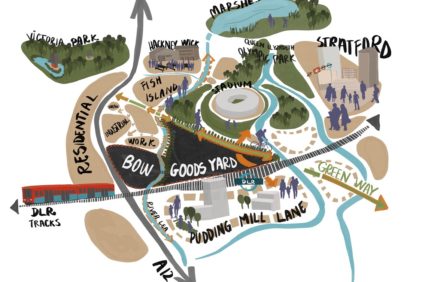Network Rail Initiates Masterplan for Bow Goods Yard Regeneration


Network Rail is launching its masterplanning process at Bow Goods Yard, East London, which will see the regeneration of over 30 acres of brownfield land.
The strategically important site is the final parcel of land to be unlocked as part of London’s 2012 Olympic and Paralympic legacy. It was initially used as the main construction hub for the Olympics, and during the games it became home to the Olympic warm up track.
Bow Goods Yard is currently home to several heavy rail freight uses. It is the last remaining industrial site in the London Legacy Development Corporation (LLDC) area and is strategically located next to the A12.
One of the largest railheads for the capital it supplies over a million tonnes of concrete and aggregate to serve the construction industry. The development has the potential to deliver a sustainable transport network for East London through rail fed warehousing with an integrated last mile logistics hub to serve Greater London. This could significantly reduce HGV journeys across London delivering a lower carbon footprint and easing congestion.
Importantly, and alongside unlocking the site’s industrial and infrastructure potential, the team will work closely with the neighbouring communities of Pudding Mill, Fish Island and Strand East to connect the future scheme with the surrounding pockets of nature, such as Queen Elizabeth Olympic Park, the River Lea and Greenway to enhance the area’s biodiversity.
Maccreanor Lavington Architects have been selected from a strong field to work in partnership with Network Rail and key stakeholders to deliver a vision for this strategic site. Montagu Evans has also been appointed as lead planning and development consultant for the scheme. A period of intensive consultation and design will take place this year with the target to submit planning in 2024.
Bow Goods Yard has the potential to deliver:
- A park-side neighbourhood of homes, leisure, industrial and open space
- The largest rail freight campus with integrated last-mile logistics hub to serve Greater London
- Workspace and workshop accommodation for an emerging and creative businesses campus
- New landscaping and open space celebrating the site’s unique location
- Connectivity with Queen Elizabeth Olympic Park and local communities
- Wider Infrastructure improvements
Network Rail and its team will continue to work closely with partners including LLDC, Greater London Authority and The London Boroughs of Newham and Tower Hamlets to deliver the last major development opportunity in 2012 Olympic zone.
Robin Dobson, Group Property Director at Network Rail said: “As the last part of the regeneration story for the Olympic Park, Bow Goods Yard is strategically connected by both road and rail. The development has the potential to create London’s largest state-of-the-art freight and last mile logistics hub to serve Greater London, alongside delivering homes, a workspace campus and open space connecting to the surrounding neighbourhoods.
“The regeneration of this strategic site demonstrates the huge importance rail infrastructure plays in unlocking the development of brownfield sites and to deliver on London’s sustainability agenda. We look forward to working closely with both communities and key stakeholders on this opportunity.”
Lyn Garner, Chief Executive of the London Legacy Development Corporation said: “This is a very welcome step forward to make significant environmental improvements to the area. The masterplan will help to balance the needs of local communities, create space for much needed housing and retain the benefits of a rail freight hub to help deliver London’s Net Zero commitments.”
Blazej Czuba, Associate Urban Designer with Maccreanor Lavington added: “We have been developing unique approaches to London’s employment locations for many years and we are thrilled to have been selected to apply them on this unique site. Bow Goods Yard has the potential to be London’s most industrious sites – it is also about its newest park and the evolving residential neighbourhoods around it.
“This project needs care and sensitivity in its design, with a fair amount of innovation. The team understands the complexity of London: its communities, its spatial character, its uses, and the mix that will create a new neighbourhood here for the people of Newham and Tower Hamlets.”